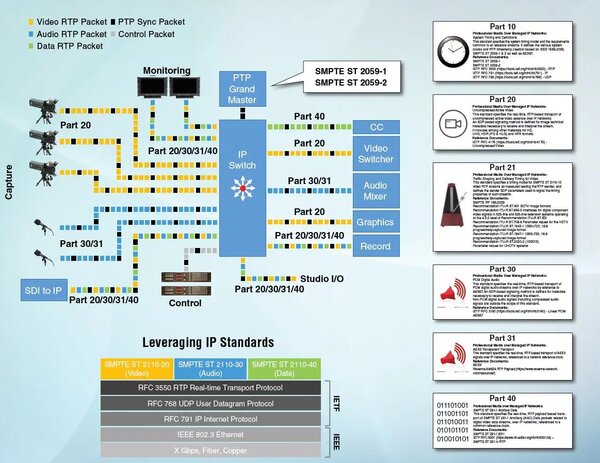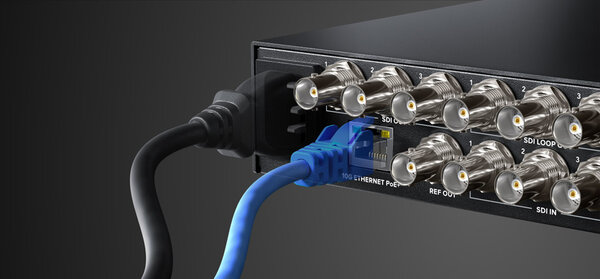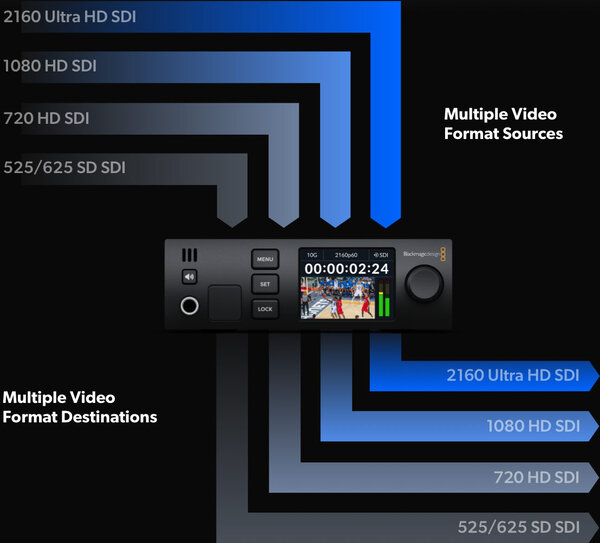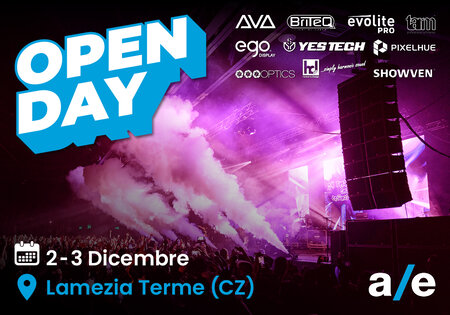Talking about SMPTE 2110 means addressing a very current topic that is transforming the broadcast world, as it enables the transport of video, audio and data signals over IP networks with unprecedented quality and flexibility. Blackmagic Design provides a complete range of solutions to integrate SDI/HDMI devices into IP infrastructures, making the transition accessible for production studios, OB vans and system integrators alike.
SMPTE 2110 is a standard – or more precisely, a suite of open standards developed by SMPTE (Society for Motion Picture and Television Engineers) – for transporting media content such as audio, video, LTC and metadata over IP networks, using UTP cabling or optical fibre.
The idea stems from the possibility of connecting device 1 to device 2 not through a single dedicated cable, as with SDI or HDMI, but via the network.
Unlike compressed protocols, 2110 allows the transmission of uncompressed 10-bit signals, with precise synchronisation and virtually zero latency. In reality, as we will see later, there is also a compressed standard, introduced only recently (see SMPTE 2110-22) as part of the broader SMPTE 2110 framework.
SMPTE 2110 is made up of several specifications (currently nine), the main ones being:
- SMPTE 2110-10: defines the overall system, timing and synchronisation between devices, handled via the PTP (Precision Time Protocol). All devices on the same network use this as their timing reference.
- SMPTE 2110-20: uncompressed video transport. Uncompressed video from any SDI or HDMI source is converted so it can travel over an IP network. SMPTE 2110 is very similar to SDI in the way source data is organised into IP packets.
- SMPTE 2110-21: traffic shaping and timing; defines how video stream packets are timed and sent across the network.
- SMPTE 2110-22: a more recent standard that defines how to create constant bit rate compressed video streams.
- SMPTE 2110-30: multichannel PCM audio (uncompressed) over the network. It is quite similar to AES67, and conversion between the two formats is therefore relatively straightforward.
- SMPTE 2110-40: transport of ancillary data (Time Code, tally, metadata).
This architecture makes it possible to separate video, audio and data streams, simplifying management and routing in complex environments. In addition, thanks to multicast support, the same signal can be sent to multiple destinations simultaneously, reducing the load on the network.
It is important to stress that SMPTE 2110 defines how data streams – video, audio and ancillary information – are transported between devices, but it does not cover how those devices establish communication with each other. To guarantee interoperability, additional protocols are required, such as STP and especially NMOS, which plays a key role by handling signal routing within the network and enabling all paths to operate correctly.
Bandwidth requirements for using SMPTE 2110
To use SMPTE 2110, the first requirement is adequate bandwidth. For example, an uncompressed 1080p 60 fps stream over SDI requires approximately 3 Gbps, so a 1 Gbps network is not sufficient. The minimum network requirement is therefore 10 Gigabit Ethernet, but there are cases where 100 Gbps is needed, particularly when multiple streams are trunked between two switches.
A 4K video signal at 50/60 fps typically occupies between 8 and 12 Gbps, which already brings us close to the limit. This is why Blackmagic Design introduced the IP10 codec, which makes it possible to carry high-frame-rate Ultra HD streams over 10G networks while maintaining broadcast quality and very low latency.
Of course, if you work at 1080p resolution, a 10 Gbps connection is more than adequate and allows multiple streams to be sent simultaneously over a single link – in this case three (10 Gbps / 3 Gbps = 3 streams).
Operational advantages and applications
Adopting SMPTE 2110 offers numerous advantages, especially compared with the SDI interface standard, since it was designed from the outset as an alternative – and potentially a replacement – for SDI:
- Scalability: the network can be expanded easily by adding new devices.
- Flexibility: dynamic routing between sources and destinations, including remote locations. If bandwidth is sufficient, multiple streams can be sent over a single link.
- No constraints on video formats: the standard is already prepared for future resolutions and frame rates (future-proof), because devices are not locked to specific speeds.
- IP-based consolidation: many of the devices previously required can now be consolidated and managed using the existing network infrastructure, without duplicating equipment.
- Lower costs: the use of CAT-6 Ethernet cables and 10G switches dramatically reduces costs compared with SDI cabling.
- Interoperability: thanks to NMOS, devices can be managed as if they were part of a virtual routing matrix.
- Lower cost over fibre: when optical fibre is used, 2110 is significantly more cost-effective than traditional fibre-based solutions, as networking SFP modules are less expensive than those designed for video production.
- Simpler for remote links: when a production involves two sites working at the same time, SMPTE 2110 allows them to be connected directly and immediately, avoiding the complexity of legacy solutions by transporting video signals natively over IP.
All these characteristics make IP2110 particularly suitable for TV studios, OB vans, live events, podcasts and corporate installations. As also emerged in discussions with Blackmagic Design specialists, the technology is already mature enough for deployment in production environments, simplifying implementation.
The Blackmagic Design ecosystem
Blackmagic built a cohesive, integrated IP ecosystem as early as spring 2024. Devices such as Studio Camera Pro, Audio Monitor 12G G3 and SmartView 4K G3 natively support IP2110, enabling video, tally, talkback and camera control to be carried over a single Ethernet cable. At present, however, IP2110 is not supported by ATEM switchers, which require the use of bidirectional converters.
ATEM Software Control remains the operational hub of the entire system, ensuring continuity between entry-level models and advanced solutions.
Blackmagic 2110 IP converters
For users looking to integrate SDI devices into IP infrastructures, Blackmagic offers a comprehensive line-up of converters:
-
Blackmagic 2110 IP Converter 3x3G: a compact device that converts three 3G-SDI sources into SMPTE 2110 IP video, via a 10G Ethernet connection capable of handling three simultaneous video channels.
-
Blackmagic 2110 IP Mini BiDirect 12G: a bidirectional converter for broadcast cameras, with XLR audio support and PoE power, also available with 10G fibre SFP ports.
-
Blackmagic 2110 IP UpDownCross 12G: standard conversion between SDI, HDMI and IP2110, ideal for live production.
-
Blackmagic 2110 IP Presentation Converter: a SMPTE 2110-compliant IP video converter designed for presentations and speeches – for example on a lectern – connecting switchers to computers, projectors, microphones and the PA system.
-
Blackmagic 2110 IP Converter 8x12G SFP: a rack-mount solution with eight bidirectional channels, designed to integrate SMPTE 2110 IP video into 12G-SDI broadcast equipment, with fibre connections for long-distance links.
All models support SD, HD and Ultra HD up to 2160p60, are compatible with PoE+ power and can be managed remotely using the free Blackmagic Converter Utility software.
Conclusions
SMPTE 2110 is a suite of open specifications that are freely available, unlike proprietary solutions such as NDI, developed by NewTek (Vizrt Group), which in its NDI Advanced SDK version requires royalties for each device, or Dante AV, owned by Audinate.
It is true that the learning curve for entering the 2110 world can be demanding, as it requires familiarity with several networking concepts. However, Blackmagic Design is working to simplify this path, providing tools that bring the user experience closer to the simplicity of plugging a cable between two devices.
The Australian company has integrated many technical aspects into the Blackmagic Ethernet Switch 360P, which is preconfigured with the necessary protocols to ensure reliable SMPTE 2110 operation, and features a front panel that allows audio and video routing directly as part of the network.
In addition, Blackmagic Design has introduced compression for 2160p 50/60 formats, slightly reducing the bitrate so that they can run over 10 Gbps Ethernet networks without compromising quality.
Finally, a point-to-point mode has also been made available, allowing a camera, for example, to be connected directly to an SDI converter without passing through a switch. This is a significant innovation compared with the traditional SMPTE 2110 approach and further extends operational flexibility.
Want to learn more?
Email us at international@audioeffetti.it

 English
English  French
French








